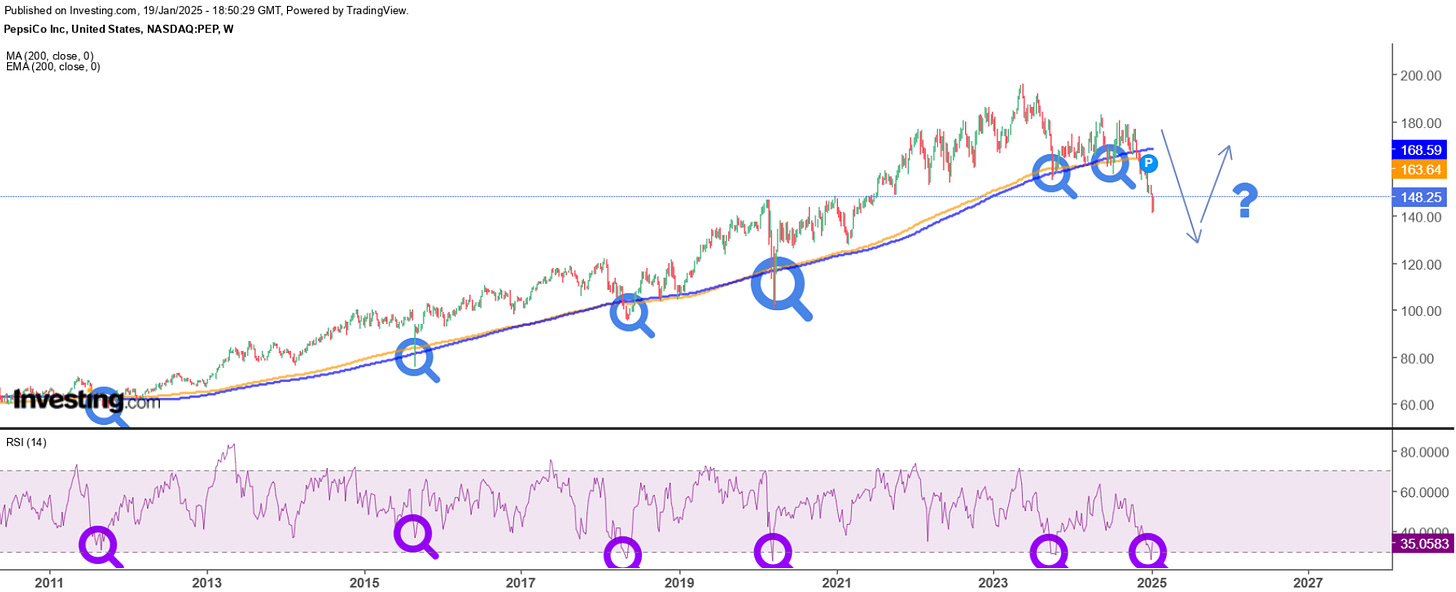200-Weekly Moving Average
This one is almost a cheat code, but it doesn’t come around often. For the long-term investor, this is where patience is rewarded. For a short-term view, the daily simple moving average (SMA) can be used.
“If you only buy quality stocks on the 200-week moving average, you’ll outperform the S&P 500 by a wide margin.” - Charlie Munger
Overall, the 200-weekly SMA is a measure of the average closing prices of an asset over the past 200 weeks. Here's a basic rundown of how it works:
- Calculation: To calculate the 200-week SMA, you add up the closing prices of the asset for the last 200 weeks and then divide by 200. This gives you the average closing price over that period.
- Smoothing Out: The purpose of the SMA is to smooth out price fluctuations and noise, giving a clearer picture of the overall trend. By using a longer time frame, the 200-week SMA is particularly useful for identifying major trends and potential reversal points.
- Trend Indicator: When the asset's price is above the 200-week SMA, it often indicates a long-term uptrend. Conversely, when the price is below the 200-week SMA, it suggests a long-term downtrend.
- Support and Resistance: The 200-week SMA can also act as a dynamic support or resistance level. Prices may find support near the SMA during downtrends and face resistance during uptrends.
The key to using the 200-weekly simple moving average for any beginner investor is not to apply it to just any stock, but to focus on high-quality stocks with a sustainable competitive advantage and healthy profits that are likely to be around for years to come. It's essential to have a strong thesis on the stock.
The 200-week exponential moving average (EMA) can also be used when you want to place more emphasis on recent prices, giving them a stronger influence on the overall average.
The reason I say this is because even if these types of companies fall below this average, you can expect them to recover back to the trendline and continue moving up. The same cannot be said for companies lacking these traits—they tend to be more volatile, leading to significant fluctuations around this average. Avoid using this method for speculative stocks.
Relative Strength Index
The Relative Strength Index (RSI) is a popular technical indicator used in the analysis of financial markets. It measures the speed and change of price movements and is used to identify overbought or oversold conditions in an asset's price.
The RSI is displayed as an oscillator on a scale of 0 to 100. The upper value is typically set at 70 to indicate that the asset is overbought, while the lower value is set at 30 to suggest that the asset is oversold. When the RSI closely reaches or crosses above 70, it may signal that the asset is overbought and could be due for a price correction (i.e., a selling signal). Conversely, when the RSI closely touches or falls below 30, it may indicate that the asset is oversold and could be due for a price rebound (i.e., a buying signal).
This is one of the simplest tools for beginners. As a long-term investor, I prefer using it on the weekly chart timeframe as it provides better long-term entry and exit points.
Illustrations
Now, let’s combine both indicators to illustrate the promising use of these tools through visuals.
Data points:
→ SMA - noted on blue line
→ EMA - noted on orange line
→ RSI - noted in purple via bottom window
Apple (AAPL)
Whether you believe the AAPL ecosystem is still intact or not is beside the point.
In its golden days, AAPL was a clear example of these indicators being used effectively. As AAPL became more valuable as a company, it started trading at a premium. Once a company reaches that status, you'll see it trade close to the 200-week MA but not quite touch it. This premium is also reflected in the RSI level. Keep this in mind for the top companies in the world. Sometimes waiting for the price to drop all the way to the trendline doesn’t happen with these types of companies, but if it gets close, it may be a good time to consider adding to your position if the thesis and fundamentals of the company are still to your standard.
Meta Platforms Inc. (META)
This is a good case to analyze. If you believed META was a strong company with a promising future, you would have been a buyer, especially during the two drawbacks in 2019 and 2020. Therefore, whatever happened in 2022-2023 would not have affected your view on the long-term viability of this company, right? The first opportunity to buy was in 2022 when it dipped back down to the 200 MA line and the RSI was well below 30. However, it fell another 100 basis points and the RSI still remained below 30. If you believed in the company's thesis, you would have continued dollar-cost averaging all the way down. As mentioned earlier, strong and fundamentally driven companies will likely always return to the 200-week MA and move higher. That is exactly what META did.
Another approach is to wait for confirmation that the stock price will hold at the 200-week MA level before initiating a position. If it breaks down, let it ride the wave until it comes back up to that level, and then buy. Once again, your conviction in the company determines the strategy. If the conviction is strong, then taking a measured risk on the price well below the 200W MA may offer higher returns. The ultimate decision is always in your hands based on your due diligence.
PepsiCo (PEP)
Now, apply what you learned from META (above) to PEP. Pepsi is a strong brand name with a variety of leading snacks and beverages in its industry, much like Coca Cola (KO), and is a staple in our daily lives. Do you think this is the end of PEP? I highly doubt it.
Look at its history and how it has followed the 200-week MA. The RSI tended to trade at or below 30, with one exception. Only recently, the price has significantly dropped below the 200-week MA target due to lawsuits and concerns that the ‘junk food’ business might be adversely affected under the new administration in the USA.
Two options:
Either you see this as a clear example of what META went through and confirm that PEP is a viable and sustainable long-term company; or,
The end of PEP is near, and it will no longer be so prominent in our daily lives.
S&P 500 (SPX)
This can also apply to ETFs. Looking at the overall S&P 500 index, this is a prime example of how you can maximize your returns during such events. There's no question that during global events like recessions or pandemics, the 200-week SMA will likely break down momentarily. However, even during minor corrections, when the asset approaches and hits this line, it often signals a great buying opportunity. The RSI can then be used to confirm this signal. As you can see, the correlation is strong. And just look at the returns thereafter—great entry points, right? Currently, you can observe a significant divergence (black line) between current prices and the 200-week MA line, suggesting that you are essentially paying for lower returns in the short-term. Any correction back to the line reduces risk and offers better long-term entry points in my opinion.
Consider joining DiviStock Chronicles’ Referral Program for more neat rewards!Please refer to the details of the referral program.









